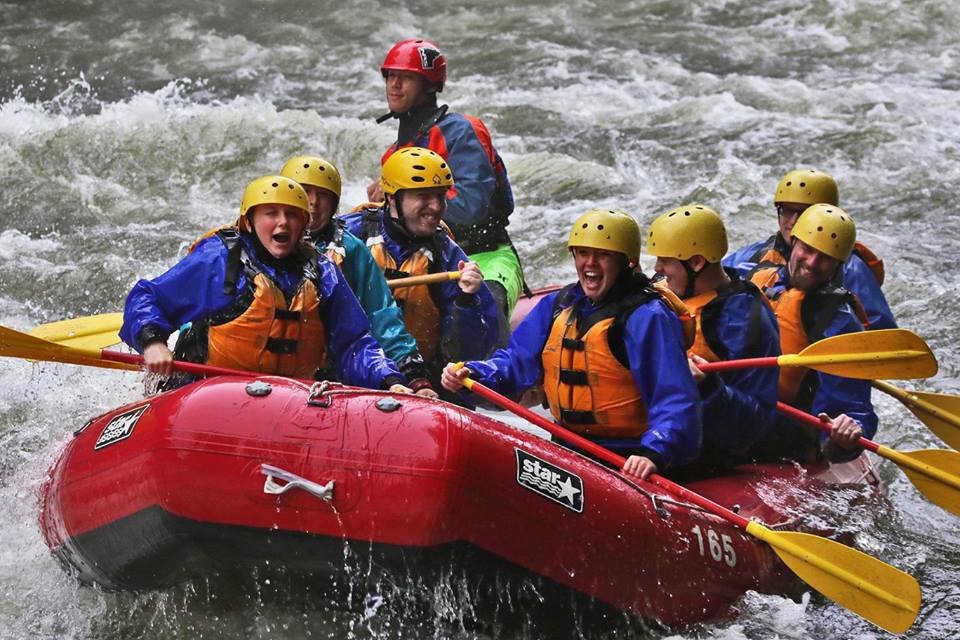
Rafting/Adaptive Rafting
About
Considered an extreme adventure sport, rafting, or white water rafting, is a popular recreational activity. With the help of a guide, you make your way down the river, maneuvering through rapids, and navigating around rocks. You can choose the experience you want, whether it be a relaxing ride down the river or an adrenaline-filled challenge.
Equipment
Rafts
Oar Boat – An oar boat is a large raft; the rafting guide either sits or stands in the center of the raft and steers it down the river using two large, long oars. Along with the instructor, an oar boat can carry up to four additional passengers and various food, supplies, and gear that might be needed during the trip. When rafting in an oar boat, the passengers are able to sit back, relax, and enjoy the adventure as the oar boat is the most stable option.
Paddle Raft – If the participant is up to the challenge, he can go rafting in a paddle raft. A paddle raft is smaller than an oar boat, but carries more people. In a paddle raft, there are four to eight participants sitting along the sides of the raft and a guide in the back. Each participant has a paddle and helps move the raft down the river, while the guide steers the raft from the back. Paddling rafting is much more extreme and exercise intensive than rafting in an oar boat.
General Equipment
When preparing for your rafting trip, there is some basic equipment you need. As with any adventure water sport, a helmet and a life jacket are essential. It is also highly recommended that you bring sunscreen and wear clothing that will protect you from the sun, such as a hat or sunglasses. In terms of clothing, consider wearing a bathing suit underneath loose athletic wear that wicks away water or dries quickly. Depending on the weather and water conditions, a wet suit or a waterproof jacket may be ideal as they will provide you with more warmth as you get wet. Also, you should always wear some type of closed-toed athletic shoe/boot or water shoes.
Adaptive Gear
Adaptive Rafting Chair – For those who need more balance or core support or who have limited trunk mobility, an adaptive rafting chair can be used. This is simply plastic lawn chair that has had the legs removed and is secured to the raft.
Thwarts – A thwart is the round, inflatable seat in the raft. If an adaptive chair is not available, the thwarts in the raft can be adjusted accordingly to offer the participant more leg, core, and back support.
Portable Access Path – A portable access path is a movable, rubber path about 5 feet in width and 30 feet in length. This access path is especially helpful for individuals using a wheelchair. The portable path creates a route that allows the individual to access the raft more easily over soft terrain, such as sand or clay, where his wheelchair is more likely to sink or get stuck.
Click here for a list of rafting equipment suppliers.
Classification
As you run down the river, you will encounter rapids, which are parts of the river where the water is very fast-flowing due to terrain, rocks, and the water level. Rapids are classified based on how severe they are.
Level 1/Class I Rapids – Small waves that tug at the boat; the calmest rapids
Level 2/Class II Rapids – Easy waves up to 3 feet tall that can be easily seen and maneuvered around through apparent, wide passages
Level 3/Class III Rapids – Waves up to 4 feet tall that require maneuvering through narrow passages, significantly rock the boat, and cause water to flood over the sides
Level 4/Class IV Rapids – Long, treacherous, turbulent rapids that require looking for and carefully maneuvering through narrow passages
Level 5/Class V Rapids – Immense, complex, hazardous, overflowing rapids that usually cause the raft to twist or spin and require meticulous precision while navigating
Level 6/Class VI Rapids – Extremely dangerous, un-runnable rapids or waterfalls
Learn More
Terminology
Before you get out on the river, there are some terms that would be helpful to familiarize yourself with.
Bow – The front of the boat
Carabiner – A clip, used to secure items into the boat, and to construct safety and rescue systems
Current – Moving water
Ferry – To cross a current or river, without moving downstream
Flip/Capsize – The boat turned upside down by a wave, a rock, or other mishap
High Water – River flow above an expected average. Makes the currents faster. Some rapids get easier, others become more difficult
Low Water – Flows below an expected average. More rocks and obstacles may show, rapids become more technical
Paddle Commands – Instructions used by the guide to communicate to the crew. Some more commonly used commands are: Forward paddle, Back paddle, Left Turn or Left Back, Right Turn or Right Back, and Stop.
Put-In – River access where a trip begins
Rapid – Where there’s whitewater; water flowing through a shallower, constricted, or steeper section forms a rapid
River Left – The left side of the river when facing downstream
River Right – The right side of the river when facing downstream
Run – A section of river that can be boated
Stern – The rear of the boat
Take-Out – River access where a trip ends
Wrap – A boat held against a rock or other object by the force of the current
Programs Near You
Click here to find a location near you!


